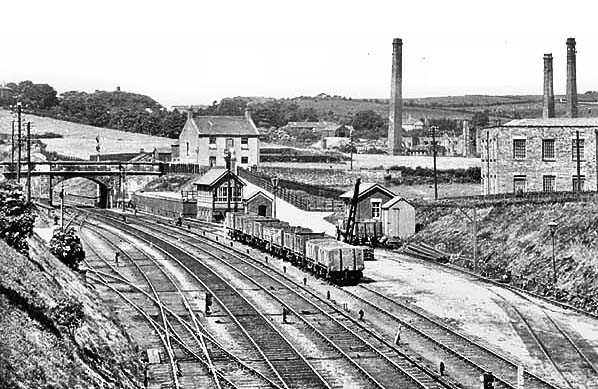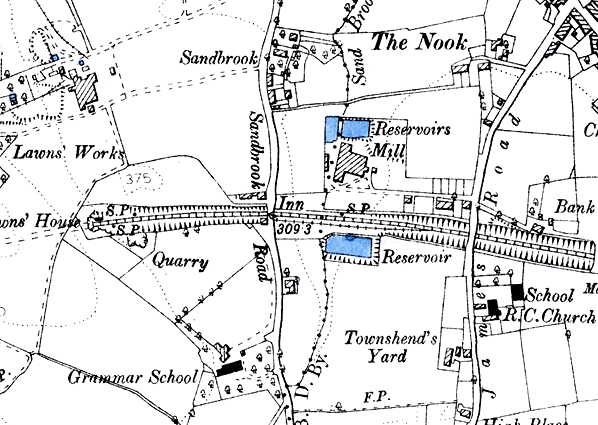Notes: The first Upholland station was situated on the Liverpool & Bury Railway (L&BR) which was authorised on 31 July 1845. The route of the line took in the towns of Wigan and Bolton and had been promoted by prominent industrialists who wanted a more direct route between the industrial areas of east Lancashire and the port of Liverpool. Since 1830 the Liverpool & Manchester Railway (L&M) had held a monopoly on trade between those areas and it did not offer a direct route. Work on the line began in January 1846 and on 9 July 1847 the L&BR merged with other companies to form the Lancashire & Yorkshire Railway (LYR).
Upholland station opened with the line on 20 November 1848. It was located a mile south of the village from which it took its name just to the south of the settlement of Tontine on the east side of Smallbrook Road. The station was 19¾ miles from Bury. Contemporary maps show a building on the up side of the line (Bury direction) but little else is known about the station.
A short distance to the west of the station was the 959yd Upholland Tunnel.
The March 1850 timetable showed five trains in each direction on Monday-to-Saturday as seen in the table below. There were three trains in each direction on Sunday. Trains mostly ran between Liverpool Great Howard Street and Rochdale via Wigan, Bolton and Bury.
Up Trains March 1850 |
Destination |
Down trains March 1850 |
Destination |
9.09am |
Rochdale |
8.40am |
Liverpool Great Howard Street |
11.20am |
Rochdale |
11.55am |
Liverpool Great Howard Street |
2.10pm |
Rochdale |
2.55pm |
Liverpool Great Howard Street |
6.28pm |
Rochdale |
4.50pm |
Liverpool Great Howard Street |
8.12pm |
Bolton |
8.22pm |
Liverpool Great Howard Street |
The Liverpool terminus at Great Howard Street was intended to be temporary as an Act had been obtained to extend the line to Tithebarn Street on 3 August 1846. The Tithebarn Street terminus (later to be named Liverpool Exchange) opened on 13 May 1850.
The first Upholland station was obviously not a success and it disappeared from the timetable after June 1852. The LYR List of Signals of 1857 has Upholland station as a location referring to a 'distance signal' for the Upholland tunnel.
Ensuring safety in the Upholland Tunnel was an important consideration and by 22 September 1869 a permissive block system was in use through Upholland tunnel. Signalmen would have been employed in primitive cabins at either end of the tunnel by that date. On 12 April 1871, the absolute block system was approved for daytime use and on 31 October 1871, for night time use as well. An LYR board minute dated 12 March 1872 recommended interlocked cabins for each end of Upholland Tunnel, this was approved the following day. A signal box called Holland Tunnel was opened at the Upholland station site sometime around 1873. Located on the up side of the line it was probably a Saxby & Farmer Type 6 box. It controlled a goods yard on the down side of the line.
The station at Orrell was renamed Orrell & Upholland until 13 October 1900 when it reverted to being simply Orrell. On the same date Pimbo Lane station was renamed Upholland, the name that it still carried in 2015.
In 1902 Holland Tunnel signal box closed and was replaced by a new signal box named Orrell West. A goods yard was also opened on the up side of the line. Accessed from the former station approach road the new yard occupied land on which the station building had been located. It had two sidings a lifting crane and a goods office. The new Orrell West signal box was an LYR box located to the east of the original but set further back from the main line. It controlled the down goods and the new up goods yard and had a 60 lever LYR frame. Only 36 levers were fitted leaving 24 spaces. There was a connection in the down goods yard to Bispham Hall Brick & Tile Works & Colliery.
On 1 January 1922 the LYR was absorbed into the London & North Western Railway which a year later on 1 January 1923 became part of the London Midland & Scottish Railway (LMS).
In 1930 the Bispham Hall Brick & Tile Works & Colliery closed. Sometime around 1933 Orrell West signal box was increased to 38 levers leaving 22 spaces. The increase was brought about through the closure of a signal box at Upholland (previously Pimbo Lane) and Orrell West took over its existing signals.
On 1 January 1948 the goods facilities at Orrell West became part of British Railways [London Midland Region] (BR [LMR]).
The line from Bispham Hall Brick & Tile Works to Orrell West down goods yard is listed as closing in 1952, but the connection to the goods yard was not disconnected until 23 November 1963.
The line from Pemberton to Orrell West was a steeply graded upwards climb (the summit being in Upholland tunnel) and banking engines were used to push trains up the incline. When heavy trains reached Orrell West the banking engines came off and were stabled in the goods yard. Drifting smoke must have been a problem for the signalmen at Orrell West signal box because in 1956 smoke deflectors were fitted to the signal box window frames.
The up goods yard at Orrell West was disconnected on 1 June 1964, but the down yard, was not disconnected until 3 July 1966. Orrell West signal box lingered on, as a block post with a crossover, until closure on 19 November 1972. By 2015 both the up and down goods yards had been developed with housing obliterating all trace of the first Upholland station and the later goods facilities. The line was still open having an hourly service of passenger trains in each direction running between Kirkby and Todmorden.
Route map by Alan Young.
The 8D Association - Dedicated to promoting the history of South Lancashire and North Cheshire railways. Web Site
Sources:
- The Lancashire & Yorkshire Railway - Volume 1 - John Marshall - David & Charles 1969
To see other stations on the Liverpool Exchange - Wigan Wallgate line click on the station name: Liverpool Exchange, Liverpool Great Howard Street,
Kirkby Royal Ordnance Factory,
Rainford, Rainford Junction,
Wigan (LYR) 2nd & Wigan LYR 1st. |




.jpg)
.jpg)
.jpg)
.jpg)


 Home Page
Home Page